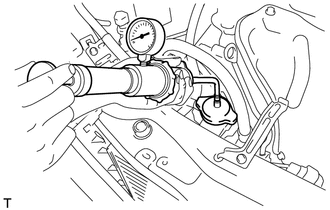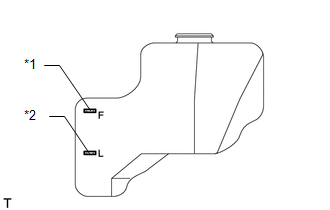Toyota Venza: Cooling System
On-vehicle Inspection
ON-VEHICLE INSPECTION
PROCEDURE
1. INSPECT FOR COOLANT LEAK
CAUTION:
Do not remove the radiator cap while the engine and radiator are still hot. Pressurized hot engine coolant and steam may be released and cause serious burns.
NOTICE:
Before performing each inspection, turn the A/C switch off.
|
(a) Fill the radiator with coolant and attach a radiator cap tester. |
|
(b) Warm up the engine.
(c) Using the radiator cap tester, increase the pressure inside the radiator to 118 kPa (1.2 kgf/cm2, 17 psi), and check that the pressure does not drop.
If the pressure drops, check the hoses, radiator and water pump for leaks. If no external leaks are found, check the heater core, cylinder block and cylinder head.
2. INSPECT ENGINE COOLANT LEVEL IN RESERVOIR
|
(a) Check that the engine coolant level is between the low and full lines when the engine is cold. Text in Illustration
If the engine coolant level is low, check for leaks and add "TOYOTA Super Long Life Coolant" or similar high quality ethylene glycol based non-silicate, non-amine, non-nitrite and non-borate coolant with long-life hybrid organic acid technology to the full line. NOTICE: Do not substitute plain water for engine coolant. |
|
3. INSPECT ENGINE COOLANT QUALITY
(a) Remove the radiator cap.
CAUTION:
Do not remove the radiator cap while the engine and radiator are still hot. Pressurized, hot engine coolant and steam may be released and cause serious burns.
(b) Check if there are any excessive deposits of rust or scales around the radiator cap and radiator filler hole. Also, the coolant should be free of oil.
If excessively dirty, clean the coolant passage and replace the coolant.
(c) Install the radiator cap.
 On-vehicle Inspection
On-vehicle Inspection
ON-VEHICLE INSPECTION
PROCEDURE
1. INSPECT COOLING FAN OPERATION AT LOW TEMPERATURES (Below 83°C (181°F))
(a) Turn the ignition switch to ON.
(b) Check that the cooling fans stop.
If not, check ...
 Radiator
Radiator
...
Other materials about Toyota Venza:
Lost Communication with AFS LIN (B124D)
DESCRIPTION
Refer to DTC B124D (Lighting system) (See page
).
DTC No.
DTC Detection Condition
Trouble Area
B124D
Malfunctions in LIN communication system
Inner rear view mir ...
Components
COMPONENTS
ILLUSTRATION
ILLUSTRATION
ILLUSTRATION
ILLUSTRATION
ILLUSTRATION
...
Initialization
INITIALIZATION
NOTICE:
Initialize the headlight leveling ECU assembly (set the zero point of
the height control sensor in the headlight leveling ECU assembly) after
the vehicle height changes due to replacement of the suspension or after
...
0.125


